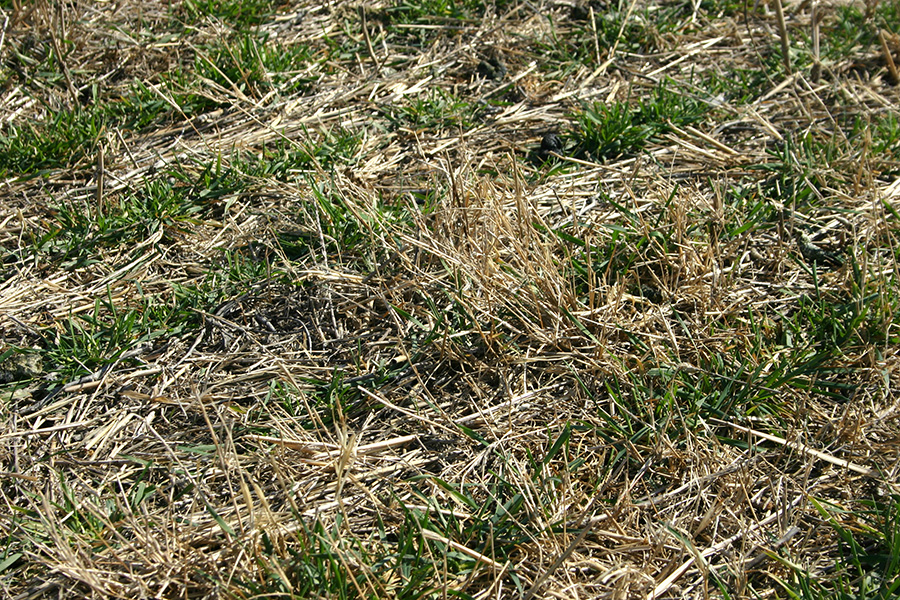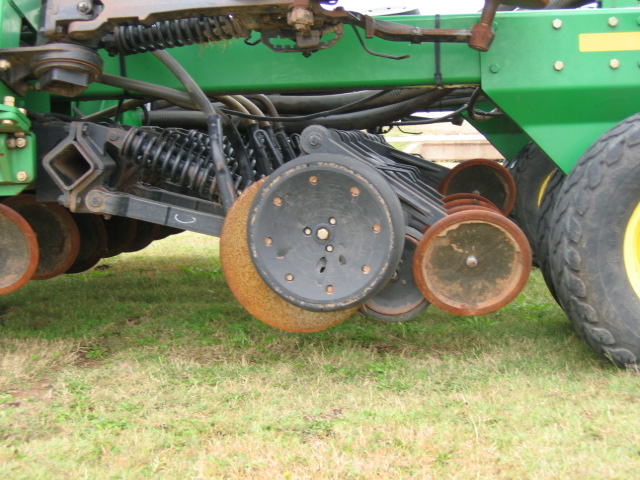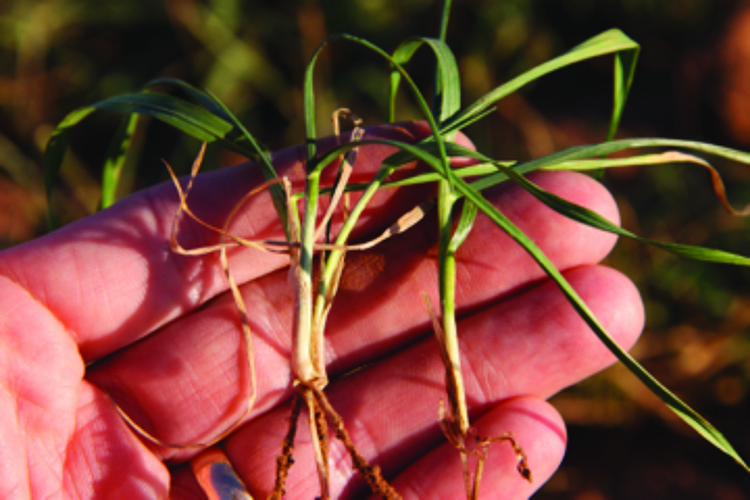Sod-Seeding Small Grains into Bermudagrass Pasture
- Jump To:
- Adaptation
- Management
- Small Grains Choice
When properly managed warm-season grasses, such as bermudagrass, are excellent forages and pasture crops for Oklahoma. Warm-season grasses, however, are dormant during the winter months, leaving producers with a need for supplemental pasture during this time. For this reason, the practice of sowing a small grain crop into established warm-season grasses (sod-seeding) is sometimes adopted in Oklahoma. Although the inputs required for this system are greater than warm-season pasture production alone, sod-seeded small grains can be a profitable system when managed properly and grain or beef prices are adequate.
Some reasons sod-seeding small grains into warm-season pasture makes sense for some Oklahoma producers include:
- Reduced cash outlay for winter supplementation of livestock. Protein supplements may not be needed when adequate small grain forage is available.
- More efficient use of available land. Warm-season grass pastures are out of production for about five months each year (November through April). A small grain crop can be grown during this period with minimal overlap.
- Additional profits from grain production are possible. Sod-seeded small grains are most frequently used for pasture only, but the potential also exists for grain production. However, more inputs are required and timing of inputs are more critical than in a forage-only or grain-only system.
- More efficient use of seasonal precipitation in Eastern Oklahoma. A significant portion of the precipitation received in eastern Oklahoma falls during the months of warm-season grass dormancy. A sod-seeded small grain crop, however, is actively growing during much of this time and can convert winter precipitation to forage more quickly than warm-season grasses alone.
- Less erosion than conventionally-seeded small grains pasture. Severe soil erosion problems can occur when soils are tilled each year for continuous small grains pasture. Implementing a sod-seeded small grain system on highly-erodable soils maintains cover, increases soil stability, and greatly reduces erosion potential.
Figure 1. Sod-seeded small grains can provide forage during winter and early spring when warm-season grasses are dormant. In high-rainfall areas there is also the potential to harvest a grain crop, but both grain yield and forage yield is much less than in a monocrop system.
Adaptation
This system is best adapted to areas east of I-35 in Oklahoma. This is especially true when a forage and a grain crop are desired. The moisture requirement of small grains peaks during late April and May (heading to soft dough). If rainfall is not sufficient to replenish soil moisture following wheat harvest, yield of the subsequent hay or forage crop may be reduced. Since the probability of receiving adequate rainfall is greater in Central and Eastern Oklahoma, these regions are normally better suited to a sod-seeding system. Of course, the potential for excellent production with this system exists anywhere under irrigation.
Management
Site preparation
In most circumstances, a pre-plant application of a non-selective, contact herbicide such as paraquat (sold under various trade names including Gramoxone Extra ) should be applied to temporarily terminate pasture growth and to eliminate weeds. A carrier of at least 15 gallons per acre of water is generally required to ensure adequate coverage. Paraquat is frequently the herbicide of choice, as it does not damage perennial grasses long-term. Systemic herbicides, such as glyphosate, have the potential to translocate to rooting portions of plants and can cause lasting damage. The other benefit of paraquat is that it does not require a significant amount of leaf area or new growth to ensure efficacy, so the warm-season grasses can be intensively grazed prior to herbicide application. As with all pesticides, there is the potential for drift and exposure, so be sure to read and follow all label recommendations as these can change from time to time.
Planting
Several planting methods can be used effectively for sod-seeding small grains pasture into established pastures. In all cases, the pasture top growth should be removed by grazing or mowing. This not only facilitates easier sowing, but also permits better sunlight availability to emerging small grain seedlings. A no-till drill in good working order is the best method to ensure good seed-to-soil contact and uniform emergence. Ideally, a drill used for sowing small grains should 1) have a row spacing of 7.5 inches or narrower, 2) provide enough down force to ensure accurate seed placement in hard soils, and 3) have closing wheels linked to the disk opener(s).
A no-till drill is not essential to establishing small grains in sod. Some producers have obtained acceptable plant stands using a conventional-drill with double disk openers. Acceptable plant stands can also be obtained by disking and then broadcasting seeding. It is important to note that this method will result in the most inconsistent plant stands from year to year, as environmental conditions play a large role in timing of emergence. Rainfall is generally required to re-fill disk furrows created during tillage and provide soil cover for seeds. Flash grazing by cattle can also help incorporate seed into the soil and remove grass residue, which will assists with germination and early-season growth.
Ultimately, there are several methods that can be used to obtain a stand of small grains sufficient for grazing or hay production. If grain production is the end goal, however, a more uniform, consistent stand is required and the use of a grain drill is advised.
Small Grains Choice
While wheat is not the only option for small grains pasture, it is the most popular in Oklahoma. Rye is usually the best forage producer in late fall and winter because it grows at cooler temperatures than other small grains. It performs very well when sod-seeded on sandy soils. Oat is an excellent spring forage producer, but may winterkill if sown in the fall in the northern half of the state. Oat and barley may also be sown in the spring (February) for grain or forage production.
If wheat is to be sown, there are several factors to consider. Variety selection is very important if a grain crop is to be harvested, but less important if forage-only production is the goal. Varieties differ greatly in their ability to recover from grazing and produce a grain crop. Consult a recent copy of the OSU Small Grains Variety Performance Tests (available at www.wheat.okstate.edu) to determine which wheat varieties recover well from grazing. If grain is to be harvested, it is also extremely important to plant weed-free seed. Weeds are very difficult to control in a sod-seeded system, and introducing additional weeds at planting only makes the job harder.
If forage or hay is the primary objective, then factors such as planting date and seeding rate are far more influential than variety in determining forage production. Increasing the seeding rate from 60 lb/acre to 120 lb/acre, for example, results in adequate forage production by most commercially available wheat cultivars.
It is also important to note that non-cash transactions that involve exchange of PVP-protected seed, such as trading truckloads of wheat, or buying grain designated for feed and then planting the seed for purposes of propagation are a violations of the PVP law as well. Ultimately the potential economic consequences of violating PVP laws far outweigh any benefit, so buy certified seed.
Figure 2. The increased use of no-till planting methods in grain cropping systems, makes high-quality no-till grain drills, such as the one shown above, readily available in the used equipment market.
Seeding Rate
Small grains seeded for forage should be sown at a much greater seeding rate than for grain. Increasing the seeding rate helps the plant close rows more quickly, intercept more sunlight, and generate more plant biomass. In addition, sod-seeding is not the optimal environment for germination and seedling growth and plant stands will likely be less than those obtained at a comparable seeding density in cropland. Suggested seeding rates for small grains drill-seeded into sod are listed below. If broadcast seeding is used, increase these amounts by 25 percent.
- Wheat – 120 to 150 lbs/ac
- Barley – 80 to 120 lbs/ac
- Rye – 90 to 150 lbs/ac
- Triticale – 80 to 120 lbs/ac
- Oat (spring) – 80 to 120 lbs/ac
Planting Date
The optimum planting date for sod-seeded small grains depends on which small grain is chosen and the method chosen to suppress pasture-grass competition and control weeds prior to planting. If paraquat is used, planting could begin around the first of September. The recovery time for bermudagrass after paraquat application is about two to four weeks, depending on how early it is applied and temperatures. This is usually long enough for small grains to become established. If chemical control is not used, the warm-season grasses should be grazed close to the ground and disked. If this option is used, planting should be delayed until October. Remember October planting will likely reduce fall forage production. An alternative strategy to late sowing would be a spring-sown oat crop planted in mid February the following year. For more information on spring-sown oat, consult Extension Fact Sheet PSS-2160 Spring-planted Oat for Grazing or Hay Production.
Fertilization
A soil test should be taken prior to seeding small grains, and any pH problems should be corrected prior to seeding. In most cases, nitrogen is required to meet crop needs. If forage is the primary objective, nitrogen should be applied pre-plant or in early winter. In broadcast seeded small grains, it is acceptable to mix seed and fertilizer as long as a uniform blend is obtained. Mixing of fertilizer and seed is not recommended in drill-seeded small grains. If forage plus grain is the end goal, it is advisable to split the nitrogen application between an early winter application and a second application after cattle have been removed. The amount of nitrogen applied depends on the yield goal of forage or grain. When determining yield goals, assume it takes 30 to 40 lbs N/ acre to produce 1,000 lbs of forage and 2 lbs N/ acre to produce one bushel of grain. The yield goal should be based on past experience and in-season assessment of yield potential.
Phosphorous (P) is especially important in the early stages of small grain growth. The most efficient way to provide it to seedlings is an in-furrow band. Banding P fertilizer into the row with seed presents little danger to seedlings; however, the amount of nitrogen plus potassium applied with the seed should not exceed 30 lbs/acre total.
Pest Control
If forage is the primary objective, in-season weed control may not be necessary. If grain is to be harvested, it is necessary to control winter annual weeds with a herbicide. Many herbicides labeled for wheat have grazing restrictions and some do not control all winter annual weeds present in Oklahoma wheat fields. So, it is extremely important to know what weeds are present and to read and follow label directions carefully. In addition to herbicides, insecticides may be required to control insect pests such as fall armyworm, grasshoppers, or cutworms.
Figure 3. The wheat plant on the left has well-established crown roots and can withstand grazing by cattle. The plant on the left has one crown root initiated and needs more growth prior to grazing.
When to Graze
Small grains require an adequate root system to anchor plants in the soil. Without an adequate root system, cattle will pull plants from the soil while grazing and reduce plant stand and future forage production potential. For this reason, small grains should not be grazed until crown roots are developed.
Another rule of thumb that can be applied to small grains such as spring oat is to delay grazing until plants are at least six inches tall. Oats and barley generally do not recover from grazing as well as winter wheat, so waiting until plants are larger and using rotational grazing strategies that leave plenty of green leaf area will increase the longevity of these small grains.
Expectations
A properly fertilized sod-seeded grain crop can provide 0.75 to 1.5 tons/acre of fall forage and two to three tons/acre of full-season forage. To achieve this type of production, however, 60 to 150 lb/acre of nitrogen is required and the bulk of this should be provided in the form of nitrogen fertilizer. A grain yield of 15 to 30 bu/acre can be achieved in a dual-use system if grazing is terminated at the first hollow stem stage of growth, weeds are managed, and adequate fertility is supplied. A yield goal of 1 ton per acre of forage followed by 20 bu/acre of grain, for example, would require 100 lb/acre of nitrogen. So, while sod-seeded small grains pasture can provide supplemental grazing and grain income, it should not be viewed as a cheap source of additional grazing.



